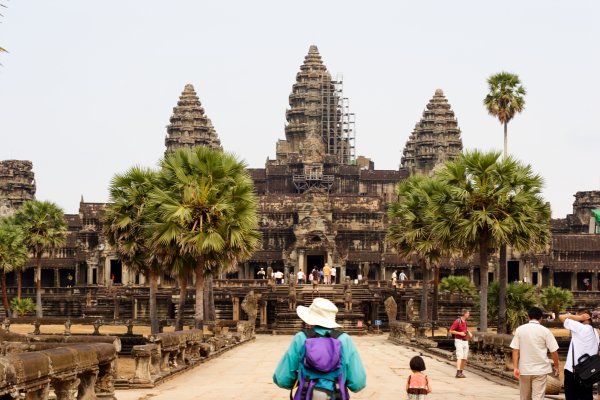Photos: Angkor Wat, Khmer architecture
For those out of the loop, I spent the last couple of weeks on holiday in Cambodia and Vietnam (with short stays in Singapore and Kuala Lumpur en route).
Naturally no visit to Cambodia is complete without a trip to Angkor Wat. Wat means temple in Khmer (Cambodian). Angkor Wat is a huge temple complex that was built in the 12th century at Angkor, which was then the capital of the Khmer Empire. At the time, the Khmer Empire was much larger than present day Cambodia (Wikipedia map). Angkor Wat is now part of Angkor Archaeological Park, near the town of Siem Reap.


Since it's difficult to see the immense scale of the temple from the ground, here is a model of Angkor Wat located at the Royal Palace in Phnom Penh (photo possibly taken by Emma):

Another famous temple is Wat Phnom, in Phnom Penh (phnom means hill in Khmer). Here is a photo of the east entrance to Wat Phnom, which demonstrates many features characteristic of Khmer architecture. (The temple itself is not particularly remarkable, other than the fact that it dates back to the 14th century; a glimpse of it can be seen in the background in the top right.)

In addition to the dvarapala (guardian warrior) and chinthe (lion-like) statues that often guard temples, the seven-headed naga is a common motif in Khmer architecture. It is often seen as a finial on railings, as demonstrated here and at Angkor Wat. Ornate triangular pediments, spires, and chofa (finial spires on roof ledges) are often used in the design of ceremonial buildings; this can also be seen in the design of the buildings at the Royal Palace:

(The foreground building here is the Moonlight Pavilion, Preah Tineang Chanchhaya, built in 1913.)
Naturally no visit to Cambodia is complete without a trip to Angkor Wat. Wat means temple in Khmer (Cambodian). Angkor Wat is a huge temple complex that was built in the 12th century at Angkor, which was then the capital of the Khmer Empire. At the time, the Khmer Empire was much larger than present day Cambodia (Wikipedia map). Angkor Wat is now part of Angkor Archaeological Park, near the town of Siem Reap.


Since it's difficult to see the immense scale of the temple from the ground, here is a model of Angkor Wat located at the Royal Palace in Phnom Penh (photo possibly taken by Emma):

Another famous temple is Wat Phnom, in Phnom Penh (phnom means hill in Khmer). Here is a photo of the east entrance to Wat Phnom, which demonstrates many features characteristic of Khmer architecture. (The temple itself is not particularly remarkable, other than the fact that it dates back to the 14th century; a glimpse of it can be seen in the background in the top right.)

In addition to the dvarapala (guardian warrior) and chinthe (lion-like) statues that often guard temples, the seven-headed naga is a common motif in Khmer architecture. It is often seen as a finial on railings, as demonstrated here and at Angkor Wat. Ornate triangular pediments, spires, and chofa (finial spires on roof ledges) are often used in the design of ceremonial buildings; this can also be seen in the design of the buildings at the Royal Palace:

(The foreground building here is the Moonlight Pavilion, Preah Tineang Chanchhaya, built in 1913.)